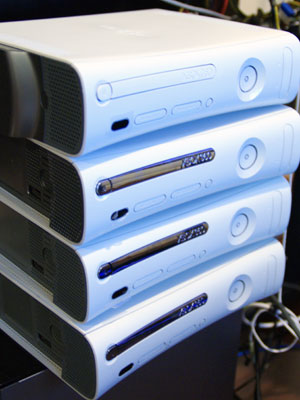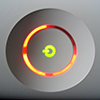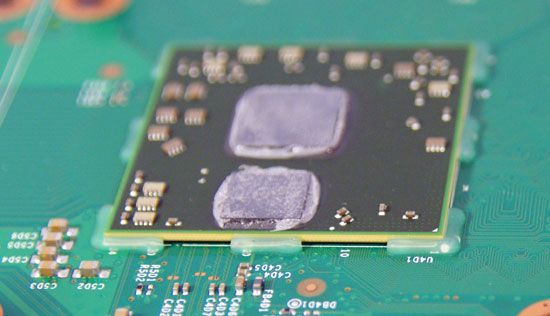Jasper Is Here: A Look at the New Xbox 360
by Anand Lal Shimpi on December 10, 2008 12:00 AM EST- Posted in
- Smartphones
- Mobile
And I thought the reason people bought consoles was to avoid dealing with the hardware nitty-gritty.
| Xbox 360 Revision | CPU | GPU | eDRAM |
| Xenon/Zephyr | 90nm | 90nm | 90nm |
| Falcon/Opus | 65nm | 80nm | 80nm |
| Jasper | 65nm | 65nm | 80nm |
First let's get the codenames right. The first Xbox 360 was released in 2005 and used a motherboard codenamed Xenon. The Xenon platform featured a 90nm Xenon CPU (clever naming there), a 90nm Xenos GPU and a 90nm eDRAM. Microsoft added HDMI support to Xenon and called it Zephyr, the big three chips were still all 90nm designs.

From top to bottom: Jasper (Arcade so no chrome on the DVD drive), Xenon, Falcon, Xenon. Can you tell them apart? I'll show you how.
In 2007 the 2nd generation Xbox 360 came out, codenamed Falcon. Falcon featured a 65nm CPU, 80nm GPU and 80nm eDRAM. Falcon came with HDMI by default, but Microsoft eventually made a revision without HDMI called Opus (opus we built a console that fails a lot! sorry, couldn't resist).
Finally, after much speculation, the 3rd generation Xbox 360 started popping up in stores right around the holiday buying season and it's called Jasper. Jasper keeps the same 65nm CPU from Falcon/Opus, but shrinks the GPU down to 65nm as well. The eDRAM remains at 80nm.
When Xenon came out, we bought one and took it apart. The same for Falcon, and naturally, the same for Jasper. The stakes are a lot higher with Jasper however; this may very well be the Xbox 360 to get, not only is it a lot cooler and cheaper for Microsoft to manufacture, but it may finally solve the 360's biggest issue to date.
A Cure for the Red Ring of Death?
 The infamous Red Ring of Death (RRoD) has plagued Microsoft since the launch of the Xbox 360. The symptoms are pretty simple: you go to turn on your console and three of the four lights in a circle on your Xbox 360 turn red. I've personally had it happen to two consoles and every single one of my friends who has owned a 360 for longer than a year has had to send it in at least once. By no means is this the largest sample size, but it's a problem that impacts enough Xbox 360 owners for it to be a real issue.
The infamous Red Ring of Death (RRoD) has plagued Microsoft since the launch of the Xbox 360. The symptoms are pretty simple: you go to turn on your console and three of the four lights in a circle on your Xbox 360 turn red. I've personally had it happen to two consoles and every single one of my friends who has owned a 360 for longer than a year has had to send it in at least once. By no means is this the largest sample size, but it's a problem that impacts enough Xbox 360 owners for it to be a real issue.
While Microsoft has yet to publicly state the root cause of the problem, we finally have a Microsoft that's willing to admit that its consoles had an unacceptably high rate of failure in the field. The Microsoft solution was to extend all Xbox 360 warranties for the RRoD to 3 years, a solution that managed to help most users but not all.
No one ever got to the bottom of what caused the RRoD. Many suspected that it was the lead-free solder balls between the CPU and/or GPU and the motherboard losing contact. The clamps that Microsoft used to attach the heatsinks to the CPU and GPU put a lot of pressure on the chips; it's possible that the combination of the lead-free solder, a lot of heat from the GPU, inadequate cooling and the heatsink clamps resulted in the RRoD. The CPU and/or GPU would get very hot, the solder would either begin to melt or otherwise dislodge, resulting in a bad connection and an irrecoverable failure. That's where the infamous "towel trick" came into play, wrap your console in a towel so its internals heat up a lot and potentially reseat the misbehaving solder balls.

The glue between the GPU and the motherboard started appearing with the Falcon revision
With the Falcon revision Microsoft seemed to admit to this as being a problem by putting glue between the CPU/GPU and the motherboard itself, presumably to keep the chips in place should the solder weaken. We all suspected that Falcon might reduce the likelihood of the RRoD because shrinking the CPU down to 65nm and the GPU down to 80nm would reduce power consumption, thermal output and hopefully put less stress on the solder balls - if that was indeed the problem. Unfortunately with Falcon Microsoft didn't appear to eliminate RRoD, although anecdotally it seemed to have gotten better.
How About Some Wild Speculation?
This year NVIDIA fell victim to its own set of GPU failures resulting in a smaller-scale replacement strategy than what Microsoft had to implement with the Xbox 360. The NVIDIA GPU problem was well documented by Charlie over at The Inquirer, but in short the issue here was the solder bumps between the GPU die and the GPU package substrate (whereas the problem I just finished explaining is between the GPU package substrate and the motherboard itself).

The anatomy of a GPU, the Falcon Xbox 360 addressed a failure in the solder balls, but perhaps the problem resides in the bumps between the die and substrate?
Traditionally GPUs had used high-lead bumps between the GPU die and the chip package, these bumps can carry a lot of current but are quite rigid, and rigid materials tend to break in a high stress environment. Unlike the bumps between the GPU package and a motherboard (or video card PCB), the solder bumps between a GPU die and the GPU package are connecting two different materials, each with its own rate of thermal expansion. The GPU die itself gets hotter much quicker than the GPU package, which puts additional stress on the bumps themselves. The type of stress also mattered, while simply maintaining high temperatures for a period of time provided one sort of stress, power cycling the GPUs provided a different one entirely - one that eventually resulted in these bumps, and the GPU as a whole, failing.
The GPU failures ended up being most pronounced in notebooks because of the usage model. With notebooks the number of times you turn them on and off in a day is much greater than a desktop, which puts a unique type of thermal stress on the aforementioned solder bumps, causing the sorts of failures that plagued NVIDIA GPUs.
In 2005, ATI switched from high-lead bumps (90% lead, 10% tin) to eutectic bumps (37% lead, 63% tin). These eutectic bumps can't carry as much current as high-lead bumps, they have a lower melting point but most importantly, they are not as rigid as high-lead bumps. So in those high stress situations caused by many power cycles, they don't crack, and thus you don't get the same GPU failure rates in notebooks as you do with NVIDIA hardware.
What does all of this have to do with the Xbox 360 and its RRoD problems? Although ATI made the switch to eutectic bumps with its GPUs in 2005, Microsoft was in charge of manufacturing the Xenos GPU and it was still built with high-lead bumps, just like the failed NVIDIA GPUs. Granted NVIDIA's GPUs back in 2005 and 2006 didn't have these problems, but the Microsoft Xenos design was a bit ahead of its time. It is possible, although difficult to prove given the lack of publicly available documentation, that a similar problem to what plagued NVIDIA's GPUs also plagued the Xbox 360's GPU.
If this is indeed true, then it would mean that the RRoD failures would be caused by the number of power cycles (number of times you turn the box on and off) and not just heat alone. It's a temperature and materials problem, one that (if true) would eventually affect all consoles. It would also mean that in order to solve the problem Microsoft would have to switch to eutectic bumps, similar to what ATI did back in 2005, which would require fairly major changes to the GPU in order to fix. ATI's eutectic designs actually required an additional metal layer, meaning a new spin of the silicon, something that would have to be reserved for a fairly major GPU change.
With Falcon, the GPU definitely got smaller - the new die was around 85% the size of the old die. I surmised that the slight reduction in die size corresponded to either a further optimized GPU design (it's possible to get more area-efficient at the same process node) or a half-node shrink to 80nm; the latter seemed most likely. If Falcon truly only brought a move to 80nm, chances are that Microsoft didn't have enough time to truly re-work the design to include a move to eutectic bumps, they would most likely save that for the transition to 65nm.
Which brings us to Jasper today, a noticeably smaller GPU die thanks to the move to 65nm and a potentially complete fix to the dreaded RRoD. There are a lot of assumptions being made here and it's just as likely that none of this is correct, but given that Falcon and its glue-supported substrates didn't solve RRoD I'm wondering if part of the problem was actually not correctable without a significant redesign of the GPU, something I'm guessing had to happen with the move to 65nm anyways.
It took about a year for RRoD to really hit a critical mass with Xenon and it's only now been about a year for Falcon, so only time will tell if Jasper owners suffer the same fate. One thing is for sure, if it's a GPU design flaw, then Jasper was Microsoft's chance to correct it. And if it's a heat issue, Jasper should reduce the likelihood as well.
Who knows, after three years of production you may finally be able to buy an Xbox 360 that won't die on you.
















84 Comments
View All Comments
pockett8 - Thursday, February 26, 2009 - link
it says 12V-12.1A on back of xbox near barcode.it doesnt say 0842X for lot but 0849X i think?
it doesnt say value bundle 2008 E but xbox 360 but something else i think the value bundle 2008 E sticker was for the us market as the uk sticker says UK/EU i think??.
and it doesnt say XGX-+00019 BUT XGX-+00024 i think not entirely sure..
but my friends what i want to know is, is this the jasper version of the console?? please help.
cheers.
Syphadeus - Sunday, January 4, 2009 - link
Well, after receiving my 360 back from it's THIRD repair (they sent me an Opus to replace my Xenon) and finding that it kept throwing me DREs at random, I decided to hunt for a Jasper today.I bought an Arcade unit from GAME here in the UK. I asked if I could have a look at the box first and they said no, so I told them to security sticker it because it was a "surprise gift". Turned out to be a Falcon (14.2A). So I'll be taking that back tomorrow.
In the meantime, I went to GameStation and asked and they let me look at the boxes - second one I looked at was a Jasper. It was really easy to see as well, didn't have to move the console, the 12.1A rating was immediately viewable through the cut-out, so I bought it and it works fine. That's another £130 I've thrown at MS - and all because I really can't be bothered to wait another 3 weeks for them to repair my replacement, which is a pretty laughable concept considering I'd had it all of four days.
Manic Penguin - Thursday, January 1, 2009 - link
I had the privilege to use an Xbox 360 Pro (60gb version) last weekend at a friends house. He had just bought the box, so naturally i wondered if it had a Jasper board in it. He told me that he wasn't sure, so I checked the back of the system. Sure enough, it had a power rating of 12,1 A. The power supply itself was a Falcon power block, but the power rating and power input jack on the Xbox both matched up to Jasper specs. I would post pics but my sister didn't let me use her camera. I will see if I can get him to send some pics via email.XtraCrispi - Friday, December 19, 2008 - link
I just bought an Xbox 360 via Dell and when I got it today I was excited to see that the manufacture date and lot numbers corresponded to what I had read for the Jasper. However after finding and reading this article I've come to realize I've got that rare breed you warned about. It's the 1st gen Xbox with HDMI and a manufactured date of 10-23-08. WTF! So mad.I might just return the thing because why spend current model prices and take an old model car, right? (No, this Xbox ain't a classic.)
Good thing I called Dell before I opened it and complained that the packaging was terrible and the Xbox box was damaged. They said I can open it up and try it out and send it back if it's damaged. I might just do it, get a refund and go get a Jasper at a local store.
HwaZy - Tuesday, December 30, 2008 - link
Wow! I was told in early Nov. that MS will not issue pre-Jasper in retail channels. They will be offered as repair replacement or refurbished only.I am lucky then and just received my Arcade from DELL today. I wasa a bittle concerned because I used discount coupon. Before I opened it, I confirmed it is indeed Jasper: 12.1V and made 10-18-2008 (3 days after the pictured). The lot#, built-in 256MB memory and bundle label and everything described. Now after opened, the 150W PSU and power connector all confirm it is Jasper. It even has one flyer for the New Experience update.
Great article!
Stop It - Saturday, December 13, 2008 - link
Hey there allI like the article, it helps those wanting to ID their systems well, except for my 360, which...makes no sense.
My 360 (Lot 0745, Made Nov 2007), uses a 175Watt PSU and the Falcon PSU input, but indicates that it uses 16,5A for its 12V rail, an indication of a Zephyr?
Now I WAS 100% sure I had a Falcon, and I'm still pretty sure, but this has confused the hell out of me, surely the Zephyr wouldn't even work with a 175Watt PSU...would it?
turbobozz - Wednesday, December 17, 2008 - link
You're not going to have a Zephyr on Falcon current, but you could have a Falcon on Zephyr current.Don't sweat it... you were probably right that you have a Falcon.
daqman - Friday, December 12, 2008 - link
I have two words for Microsoft and any other chip maker fo that matter....Gallium Arsenide! Heat would be a non-factor because there is very little resistence with said substance, therefore it would increase speed also.turbobozz - Wednesday, December 17, 2008 - link
What are you smoking?You don't know what you are talking about.
Using GaAs would make it far, far more expensive.
And it you're very much misrepresenting the true benefits GaAs has over Si
(Which aren't generally applicable to the 360.)
Wikipedia has a decent article on GaAs... look it up.
araczynski - Friday, December 12, 2008 - link
so far my late 2006 xenon has been working flawlessly, i'll keep my fingers crossed that it stays that way. i wonder if anyone has any records as to what ratio of the failed units were xbox live gold members/players :)i don't do multiplayer, so perhaps my xbox loves me for not putting it through all the trash talking wannabe kid drivel.
i can hope can't i?